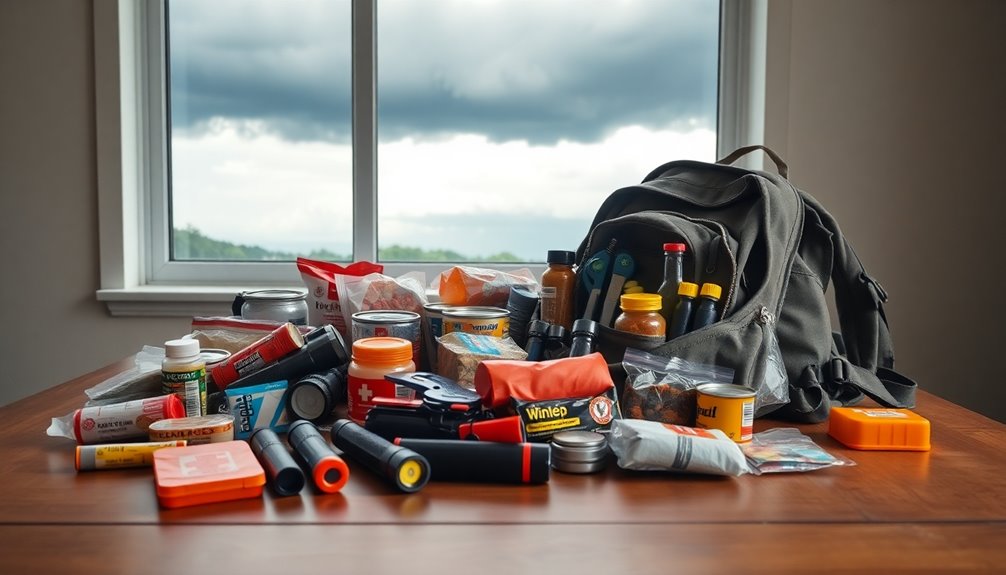Using NOAA Weather Radio and alert apps keeps you informed during severe weather, whether you’re at home or on the go. NOAA Weather Radio provides continuous, authoritative updates and warnings, even in remote areas. Mobile alert apps send instant notifications with detailed instructions, no matter where you are. Combining both tools guarantees you won’t miss vital alerts. Keep your devices updated and familiarize yourself with alert sounds to respond quickly — there’s more to learn to stay fully prepared.
Key Takeaways
- Use NOAA Weather Radio for continuous, authoritative weather updates and emergency alerts, especially in remote areas.
- Install and configure mobile alert apps to receive instant, location-based notifications on your smartphone.
- Regularly test both NOAA radios and apps to ensure alerts are recognizable and functioning properly.
- Familiarize yourself with alert sounds and notifications to respond quickly during severe weather events.
- Combine NOAA Radio and mobile alerts for comprehensive, real-time emergency information and improved preparedness.

Staying informed about severe weather is essential, and NOAA Weather Radio along with various alert apps make it easier than ever. By paying attention to these sources, you can improve your emergency preparedness and guarantee you’re ready to respond quickly when danger strikes. NOAA Weather Radio broadcasts continuous weather updates, alerts, and warnings directly from the National Weather Service, providing crucial information no matter where you are. It’s designed to reach even remote areas, making it a reliable tool for staying safe during storms, tornadoes, or other emergencies. When you tune in, you receive real-time alerts that help you make informed decisions, avoiding unnecessary risks and guaranteeing your safety.
In addition to NOAA Weather Radio, mobile alerts from various apps are transforming how you receive emergency information. These apps send instant notifications directly to your smartphone, often including detailed instructions and updates. With mobile alerts, you don’t have to be glued to a radio or TV; instead, you get alerts wherever you are—at home, at work, or on the go. Many apps allow you to customize alerts based on your location, so you only get notified about the severe weather affecting your area. This targeted approach helps you stay focused and prepared without being overwhelmed by irrelevant alerts. Features like push notifications ensure you see alerts immediately, even if your device is locked, so you won’t miss critical information when seconds count.
Using these tools together enhances your overall emergency preparedness. You can listen to NOAA Weather Radio for extensive, authoritative updates, while your mobile alerts keep you informed of the latest developments in real-time. This dual approach guarantees you’re not caught off guard, giving you peace of mind and more control over your safety plan. It’s important to test your alerts regularly and familiarize yourself with the notifications’ sounds and appearance so you recognize them instantly. Keep your devices charged and within reach, especially during severe weather seasons, to avoid missing critical alerts. Remember, the key to effective emergency preparedness is being proactive: stay informed, have a plan, and leverage technology to keep yourself and your loved ones safe.
Additionally, understanding the shelf life of alerts and ensuring your devices are up-to-date can improve your response time during an emergency. Ultimately, integrating NOAA Weather Radio and mobile alerts into your daily routine boosts your readiness for any weather emergency. They provide a reliable, timely flow of information that empowers you to act swiftly. Whether it’s a tornado warning, flash flood alert, or winter storm advisory, these tools help you stay one step ahead. By making use of both traditional broadcasts and modern mobile alerts, you enhance your resilience and ensure that when severe weather hits, you’re prepared to respond effectively.
Frequently Asked Questions
Can NOAA Weather Radio Alert for Non-Weather Emergencies?
NOAA Weather Radio primarily alerts you to weather emergencies, but some models and channels do broadcast non-weather emergencies, like natural disasters or Amber Alerts. For complete emergency preparedness, rely on radios with broad coverage and customizable alerts. Keep in mind, radio coverage can vary, so it’s wise to have multiple alert sources, like apps or local alerts, to stay informed about all types of emergencies beyond weather issues.
Are NOAA Weather Radio Alerts Available Internationally?
Surprisingly, NOAA Weather Radio alerts don’t have international coverage, so you won’t get alerts outside the U.S. and its territories. While it’s great for local emergencies, it’s limited by alert restrictions that keep you from receiving warnings across borders. So, if you’re traveling or living abroad, you’ll need alternative apps or alert systems, since NOAA’s signals are designed primarily for domestic safety, not global alerts.
How Reliable Are Weather Apps During Power Outages?
Weather apps’ reliability during power outages depends on your device’s battery life and signal reliability. If your device has a good battery and you’re connected to Wi-Fi or cellular data, you can still get alerts. However, if power or signal drops, notifications might stop. To stay safe, keep your device charged, have a portable charger handy, and consider alternative alerts like NOAA Weather Radio.
Do Apps Provide Customizable Alert Settings?
Think of weather apps like a personal alarm system—ready to alert you when danger’s near. Yes, many apps offer custom alert features, letting you set specific thresholds for temperature, wind, or severe weather. You can also tweak app notification settings to control how and when you get alerts. This way, you’re always prepared, receiving timely updates that fit your needs and keeping you one step ahead of weather surprises.
Can NOAA Weather Radio Be Used in Remote Areas?
NOAA Weather Radio can be used in remote areas if your device has satellite communication capabilities, ensuring you stay connected even without cellular service. This makes it a crucial tool for emergency preparedness, providing continuous alerts during severe weather events. Keep in mind that traditional NOAA radios rely on radio towers, which may have limited coverage in very isolated locations. Satellite-enabled radios are your best bet for reliable alerts anywhere.
Conclusion
By tuning into NOAA Weather Radio and apps, you’re like a vigilant lighthouse guiding you safely through stormy seas. These tools act as your trusty compass, lighting the way through dark clouds and turbulent winds. With alerts at your fingertips, you stay one step ahead, turning chaos into calm. Embrace these life-saving signals, and let them be your steady anchor amid nature’s unpredictable mood swings. Stay alert, stay safe, and weather any storm with confidence.










